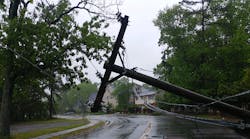Latest from C&E/NetDev Ops/GIS/Open-Source Networks
Supply Chain Risk Management Solutions —
Hurricane Dorian is once again reminding us how quickly telecommunications can essentially be knocked down in a short amount of time in the Bahamas and elsewhere.(1) When Hurricanes Irma and Maria hit Puerto Rico and the US Virgin Islands in 2017, communications networks were essentially wiped out. More than 95% of cell sites were out in Puerto Rico, and 77% of cell sites were knocked offline in the Virgin Islands.(2)
The big disasters rightfully get all of the attention about all of the disruptions to phone and cell service. However, leaders in the telecom industry deal with smaller but still difficult situations all the time.
Supply Chain and Safety?
Around the world, 2.3 million workers have died from work-related accidents or diseases.(3) In 2017, the US Bureau of Labor Statistics reported 5,147 fatal work injuries across the US. US executives face the consequences of deaths and injuries at the workplace.(4) And unfortunately, risks can grow when a company is relying on outside suppliers and contractors.(5)
Telecommunication companies need reliability and safety across their supply chain. For example, think of cell tower installers. Many of these tower climbers are third-party workers. And many of them risk their lives too often. The bottom line is this: supply chain risk management can’t just be an afterthought, it’s a vital tool for survival.
InvisiLight® Solution for Deploying Fiber
April 2, 2022Go to Market Faster. Speed up Network Deployment
April 2, 2022Episode 10: Fiber Optic Closure Specs Explained…
April 1, 2022Food for Thought from Our 2022 ICT Visionaries
April 1, 2022Worker Scarcity
Thanks to video, big data, the Cloud, and more, end users’ demands are skyrocketing for those high-bandwidth services. As a result, the telecom industry has its hands full managing strategic partnerships and new projects.
Unfortunately, the low unemployment rate and the lack of qualified contractors has led to an unequal balance between demand and availability. Network providers are now on a mad search for the best contractors and suppliers. Once found, they must quickly qualify those contractors to ensure they meet their internal quality and safety standards.
The good news is that a centralized evaluation scorecard can be used as part of a supply-chain risk-management system that can improve your company’s procurement processes.
First, determine how the evaluation criteria relate to the characteristics you are measuring. Do the measurements relate to your corporate/department strategies and goals? For example, if your objective is to increase on-time delivery of x-product, you need to ensure that the supplier management method you choose uses leading and lagging indicators. This will allow you to show how proper delivery has affected business in the past, and how improvements will benefit future business.
As you implement this scorecard policy to track supplier management, you will see an improvement with your suppliers simply by displaying your interest in their performance. The goal is to maintain or improve supplier performance by employing corrective actions when necessary.
While not every supplier will walk away having a perfect report card, you will have reliable quantitative measures of performance with which to gauge supplier management and improve your ROI. This contractor-prequalification management system will give you the feedback you need to then implement a more effective program.
By identifying the issues and improvements that need to be made, supplier/contractor-performance management processes can help reduce risks, lessen administrative burden, lower costs, and create a leaner system.
6 Steps to Reduce Complacency
Below are some ways to help your company transform with the times and manage risks associated with outsourced employees:
Step 1: REVIEW
Find out how your employees and anyone in the company’s supply chain are being trained for safety.
Step 2: IDENTIFY
Create a checklist of risks, and determine if your company or supply chain has gaps in handling hazards and meeting standards.
Step 3: PLAN
Study the international standard (ISO 45001). Update existing procedures to meet and enforce the new standard.(6)
Step 4: DOCUMENT
Make sure all safety procedures are well-documented.
Step 5: EDUCATE
Train or retrain your employees on ISO 45001. Your plan should include how employees are taught and tested.
Step 6: AUDIT
Conduct regular audits of your employees and your suppliers to make sure compliance requirements are always met.
One company that effectively did this is SBA Communications Corporation (https://sbasite.com/). The company owns and operates wireless infrastructure that is used by mobile carriers in the US, Canada, Central America, and South America. The telecom infrastructure provider has about 2,500 independent contractors working on 30,000 cell towers in North, Central, and South America. Many of the locations are remote and dangerous.
In 2014, SBA Communications was seeing a spike in cell-tower-related injuries. To change this, the company had to find a way to make sure all contractors met safety and insurance requirements. They also needed a method to reach contractors when issues came up on the job as well as a channel to alert workers of urgent issues and safety updates.
The company didn’t have the staff to review every contractor’s file to get all that done. So, they enrolled Avetta to deploy their supply chain risk management software. This enabled SBA to verify safety and insurance requirements for contractors and improved their accountability. SBA is now saving a significant amount each year on employee costs while it is also seeing an increase in safety and efficiency.
Solutions
While tragedies and disasters typically put the spotlight on major risks in your supply chain, you face numerous smaller risks daily. By focusing your efforts on safety through supply chain risk management, you may be able to realize some cost savings while improving safety. In addition, as you review, educate, and audit, both your employees and suppliers, you’ll be better able to stay ahead of the curve of technological change.
Like this Article?
Subscribe to ISE magazine and start receiving your FREE monthly copy to-day!
Resources and Notes
1. https://www.usaid.gov/crisis/dorian/fy19/fs2
4. https://www.bls.gov/news.release/pdf/cfoi.pdf (2018 statistics will be available in December 2019)
5. https://www.sdcexec.com/sourcing-procurement/article/12207278/your-suppliers-risk-is-your-risk
6. https://www.iso.org/iso-45001-occupational-health-and-safety.html








